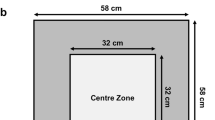Abstract
Rationale and objectives: Rodents tested in the elevated plus maze model of anxiety only show an anxiolytic response to benzodiazepines on their first exposure to the maze. The present study investigated whether a similar phenomenon occurs with benzodiazepines in a different model of anxiety that involves exposing rats to the odor of a predator. Methods: Testing took place in a rectangular arena containing a cat odor-exuding collar at one end and a small ”hide box” at the opposite end. Rats were initially familiarized with the odor-free apparatus for 20 min and then placed back in the apparatus 24 and 48 h later in the presence of cat odor. Results: Vehicle-treated rats displayed marked avoidance of the cat odor on both first and second exposures, spending most of the session in the hide box and very little time near the odor source. In contrast, rats given a low dose of midazolam (0.375 mg/kg) during first exposure spent considerable time in close proximity to the odor source and much less time in the hide box. Rats given midazolam (0.375 mg/kg) on their second exposure to cat odor displayed no such anxiolytic effect of the drug. Rats given midazolam (0.375 mg/kg) on both exposures showed a potent anxiolytic effect of the drug on each occasion. This pattern of results was replicated with a higher dose of midazolam (0.75 mg/kg). A further experiment showed that rats previously exposed to cat odor showed high levels of hiding in the test environment 24 h later even when the cat odor was no longer present. This conditioned fear was blocked by midazolam (0.75 mg/kg) suggesting that the ineffectiveness of midazolam on second exposure to cat odor is not due to a failure of the drug to affect conditioned fear. Conclusions: The ineffectiveness of midazolam in odor-experienced rats parallels the results obtained with benzodiazepines in the elevated plus maze. Such results may help illuminate the comparative lack of efficacy of benzodiazepines in treating certain types of anxiety disorders in humans.
Similar content being viewed by others
Author information
Authors and Affiliations
Additional information
Received: 14 February 1999 / Final version: 26 June 1999
Rights and permissions
About this article
Cite this article
McGregor, I., Dielenberg, R. Differential anxiolytic efficacy of a benzodiazepine on first versus second exposure to a predatory odor in rats. Psychopharmacology 147, 174–181 (1999). https://doi.org/10.1007/s002130051158
Issue Date:
DOI: https://doi.org/10.1007/s002130051158




